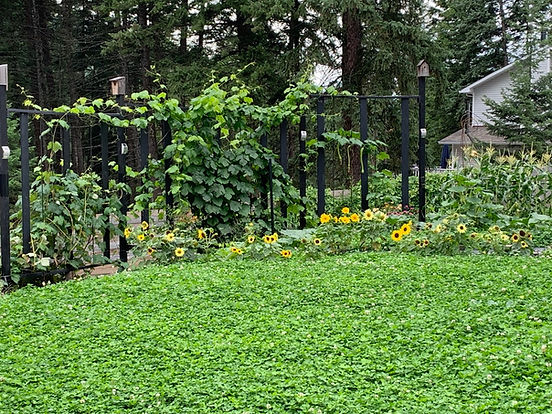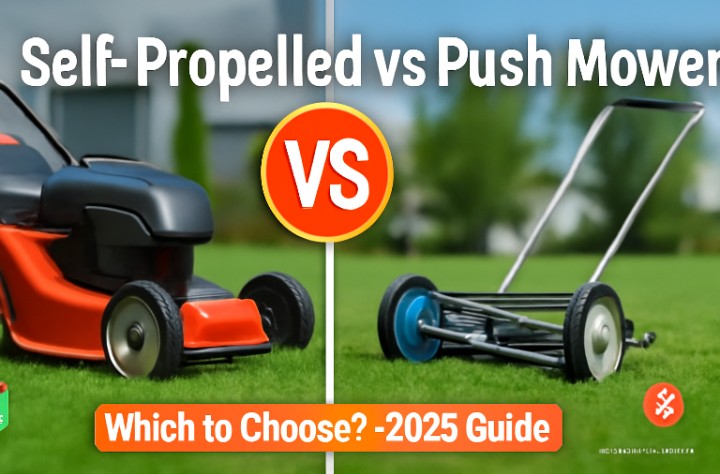Key Benefits for Homeowners
Picture Saturday morning lawn care routines in your neighborhood. Some folks spend hours wrestling with sprinklers and staring at brown patches. Others relax with coffee, enjoying their low-maintenance yards. Traditional lawn care feels like a part-time job sometimes. Weekend after weekend of watering, fertilizing and troubleshooting problems. Then you discover clover, a completely different approach to lawn care.
Here is what’s fascinating about clover roots. While grass roots stay shallow, clover develops deep root systems that hunt for moisture far below the surface. This explains why clover lawns stay green during dry spells when grass turns brown. The maintenance difference becomes obvious quickly. Clover requires minimal attention maybe occasional weeding. Traditional grass demands constant care, repairs and seasonal treatments.
Money savings add up fast with clover. Traditional lawns need regular fertilizer, frequent watering and various treatments throughout the year. Clover essentially takes care of itself after establishment.
Expert Recommendations
Spring planting works well after frost danger passes in your area. Fall planting often provides even better conditions for establishment.
Tony Koski from Colorado State University, a turf expert with decades of experience, points out that clover actually improves soil conditions as it grows. Even problematic soils can become healthier over time. Poor soil conditions do not prevent clover success. This hardy plant adapts to various soil types and gradually improves whatever conditions it encounters.
Choosing the Right Clover Variety
Popular Clover Types
White Clover is like that reliable friend everyone has. Nothing fancy but it shows up every time. You will find it everywhere Home Depot, local nurseries, even some grocery stores carry it. But let me tell you about Microclover. This stuff is amazing. Varieties like ‘Pirouette’ and ‘Pipolina’ stay neat and tidy. My kids can play soccer without getting covered in flower stains. Plus, it looks surprisingly grass-like from the street.
Lisa my neighbor went with microclover last year. Her homeowners association gave her grief initially. Now they are asking for her secret. It just looks that good.
Crimson Clover is pure drama. Those bright red flowers in spring? Instagram worthy. But heads up, it is annual so you will replant each year.
Expert Selection Criteria
Light requirements are not too fussy. Four hours of sun works fine. I have got a section under my maple tree that gets maybe three hours still growing, just slower.
Traffic tolerance matters with kids and pets. Max, my golden retriever, has his favorite running path across the backyard. Microclover handles its daily sprints better than regular white clover ever did. pH testing sounds boring, but it saves headaches. Mine tested at 5.5 initially too acidic. Scattered some lime, waited six weeks, retested at 6.8. Perfect. The difference in growth was obvious.
Pre-Planting Preparation
Site Assessment
Time for brutal honesty about your current lawn. Those dead patches are not “dormant” they are dead. Standing water after rain means drainage problems. Weeds everywhere? Your grass already lost the battle. I put off dealing with reality for two years. Kept hoping grass would magically recover. Finally admitted defeat when dandelions outnumbered grass blades three to one.
A basic soil test kit costs ten bucks at any hardware store. Takes five minutes. Tells you everything you need to know. Best ten dollars I ever spent on lawn care.
Ground Preparation Steps
This part feels like overkill, but trust the process. Removing existing grass plus six inches of soil seems insane. Skip this step, and you will fight grass roots forever. Renting a sod cutter changed my life. Forty bucks for the day, done in two hours. Hand digging would have taken weeks and destroyed my back.
Soil replacement costs add up fast. I went through fourteen bags for a small front yard. But cheap soil gives cheap results. Spend the money here, everything else depends on good soil. Level as you go. A basic rake works perfectly. Pick out rocks, sticks, and that random toy truck buried for three years.
Step-by-Step Planting Process
Seeding Technique
Here is your magic formula: one pound covers 300-600 square feet. Start conservative if you are nervous. You can always add more. Broadcasting by hand feels old-school but works great. I tried a fancy spreader once complete waste of money. Just keep your passes even and overlap slightly.
My biggest mistake? Being stingy with seed. Those bare patches haunted me all summer. Second time around, I used extra seed. Problem solved. Cover seeds lightly with soil – about a quarter-inch deep. Think of it like tucking them into bed. Too deep and they can not sprout. Too shallow and birds eat them.
Initial Care Protocol
This phase requires actual attention. Keep soil consistently damp for two weeks. Not soggy, not dry like a wrung-out sponge. Evening watering works best. Less evaporation, better absorption. I set my phone to remind me every day at 6 PM. After two weeks, the reminders stopped.
First sprouts appear around day seven if conditions are right. It could take up to ten days in cooler weather. Don’t panic if some areas lag behind.
Growth Timeline and Care Schedule
Week 1-2: Germination Phase
Uneven sprouting drives perfectionists crazy. Edges usually germinate first. Slightly sloped areas often do better initially. Completely normal. Daily moisture checks become routine. Stick your finger into the soil about an inch deep. Should feel damp, not wet. Adjust watering accordingly. Brown patches at this stage usually mean overwatering. Back off and let things dry out slightly. Clover hates wet feet.
Month 1-2: Establishment Phase
This phase tests your patience more than anything. Growth looks sporadic and thin. Every lawn care forum will tell you this is normal. They are right. Sunny spots fill in noticeably faster. Shaded areas take their sweet time but eventually catch up. Don’t give up on slow areas too quickly. Spot seeding thin areas works well. Scratch the surface lightly, add seeds, keep moist. Much easier than starting over completely.
Month 3-12: Maturation Phase
Month three brings the “aha” moment. Your lawn starts looking intentional instead of experimental. Neighbors begin asking questions. Summer care stays are minimal. Water during extreme heat, if you want. Skip it if you are feeling lazy. Clover adapts either way. Year one completion feels like graduation day. Dense, green coverage that laughs at drought conditions. You will wonder why anyone bothers with traditional grass.
Expert Tips and Troubleshooting
Common Planting Mistakes to Avoid
Incomplete grass removal kills more clover dreams than anything else. Those sneaky grass roots don’t give up quietly. They will crowd out clover every time. Inconsistent watering during germination ranks second in failure causes. Miss a few days during week one? You are starting over. Set reminders and stick to them.
Hot weather planting rarely succeeds. July and August plantings usually fail miserably. Save your money and wait for cooler temperatures.
Problem-Solving Strategies
Patchy growth happens to everyone. Target problem areas with additional seed rather than replanting everything. Usually fixes the issue completely. Weed invasion concerns fade as clover establishes. Dense clover crowds out most weeds naturally. Give it time to thicken up.
Shade struggles might need different solutions. Consider alternative ground covers for heavily shaded spots where clover consistently fails.
Professional Maintenance Tips
Mowing becomes optional with microclover varieties. They naturally stay shorter and neater. When you do mow, keep blades set high. Fall overseeding maintains density long-term. Light application every second year keeps everything looking thick and healthy.
Work with clover’s natural tendencies instead of fighting them. Life gets much easier when you stop trying to control everything.
What to Expect: Realistic Timeline
Short-term Results (0-3 months)
Instagram perfection takes time. Your lawn will not look magazine-ready immediately. Embrace the messy middle phase.
Uneven coverage and slow establishment challenge Type-A personalities. Remember – you are building something sustainable, not creating instant gratification. Patience requirements exceed traditional grass by several weeks. But the long-term benefits make the wait worthwhile.
Long-term Success (1+ years)
Year two delivers the real magic. Dense coverage, natural weed resistance, genuine drought tolerance. Neighbors start getting jealous. Seasonal changes create year-round visual interest. Spring brings rapid green-up. Summer delivers flowers and butterflies. Fall growth naturally thickens coverage.
Self-seeding reduces future work significantly. Mature clover lawns practically maintain themselves. Seriously. Deep root systems access moisture traditional grass can not reach. Your lawn stays green while neighbors’ turn brown during dry spells.
When to Seek Professional Help
Assessment Services
Professional soil analysis reveals hidden problems before they become expensive mistakes. pH levels, nutrient deficiencies, drainage issues – worth knowing upfront.
Site evaluation determines whether clover suits your specific situation. Not every property benefits from complete lawn conversion.
Professional installation makes sense for large areas or if physical limitations make DIY unrealistic. Experience prevents common pitfalls.
Ongoing Support
Even low-maintenance lawns occasionally need expert diagnosis. Professionals identify problems quickly and accurately. Maintenance services exist for busy homeowners who want results without the time investment. Focus on family time instead of lawn chores.
Transition assistance smooths the conversion process. Heavy lifting goes faster with professional equipment and experienced crews.
Your journey from grass to clover will transform more than just your lawn. While neighbors stress about watering schedules and fertilizer applications, you will be inside enjoying your weekend. That cold drink on the porch? It tastes better when your lawn practically takes care of itself.






